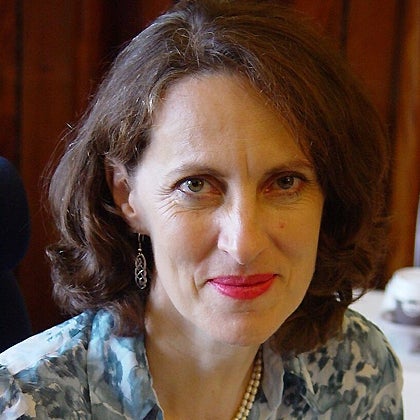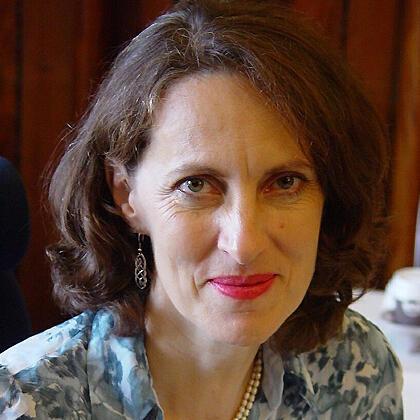How to Avert a Climate Catastrophe
Share
- Details
- Transcript
- Audio
- Downloads
- Extra Reading
After the UN Climate Action Summit in September, our Environment Professor will be talking to three experts about whether we still have a meaningful chance of averting a climate catastrophe, and how we can get there. The Extinction Rebellion protests pushed climate up the news agenda early in 2019, but what has happened since then, and what is happening globally?
Professor Vicky Pope will discuss the challenges of climate modelling and reduction of emissions; Dr Damien Short will talk about why we need to legislate against Ecocide; and Professor Geoffrey Beattie will discuss the psychology that stops us from taking action.
Download Transcript
30 September 2019
How to Avoid a Climate Catastrophe
The Limits to Growth and the Ecological Crisis: What Role For A Crime of Ecocide?
Damien Short
It is the interaction of the economy + technological change + energy prices that determines growth and hence
emissions – not just the source of fuel. Energy is an essential pre-requisite of economic activity and growth.
The acute problems envisaged by the 1972 Limits to Growth report are occurring roughly as predicted;
- The move from “conventional” to “unconventional” energy and mineral resources is an indication we have hit a major limit. BUT, as we know, politicians are ignoring these limits.
- Planning a sustainable future requires acceptance of the 'limits to growth'.
Extreme Energy
As conventional resource supplies diminish, new, more energy intensive, technologies are allowing Oil and Gas companies move in to new ‘frontiers’ and gain access to ‘unconventional’ supplies:
- (even) deeper sea drilling, drilling in the Arctic,
- excavations of the Boreal forests of Alberta,
- mountain top removal,
- and onshore fracking in ‘developed’ countries.
The Process of Extreme Energy
‘Extreme Energy is the process whereby energy extraction methods grow more intense over time, as easier to extract resources are depleted. The process is driven by unsustainable energy consumption and is important because extraction effort is strongly correlated with damage to both society and the environment’.
Short, D, J Elliot, K Norder, E Lloyd-Davies and J Morley, 'Extreme Energy, Fracking and Human Rights: A New Field for Impact Assessments?' International Journal of Human Rights, 11th May, 2015.
Energy inefficiency and societal use value - amount available to society drops as energy input levels increase.
Unconventional Energy and climate crisis
‘we must rapidly phase out coal emissions, leave unconventional fossil fuels in the ground, and not go after the last drops of oil and gas. In other words, we must move as quickly as possible to the post-fossil fuel era of clean energies.’ James Hansen
‘the only responsible action with regard to shale gas, or any “new” unconventional fossil fuel, is to keep it in the ground — at least until there is a meaningful global emissions cap forcing substitution. In the absence of such an emissions cap, and in our energy hungry world, shale gas will only be combusted in addition to coal — not as a substitution, as many analysts have naively suggested.’ Kevin Anderson: Tyndall Centre
Why Growth?
The idea of economic growth is that it gives us all more to make us 'happier’. Recent studies suggest that this is not the case, and that fifty+ years of growth has not made us significantly happier AND has massively increased our ecological problems to crisis levels.
Summary - current predicament:
-
- peaking resources,
- drive towards extreme energy
- anthropogenic climate change
- ecological crisis
Solutions?
International law: Ecocide?
What lessons can we take from the UN history of genocide and ecocide?
Genocide was politically diluted from a broad sociological concept that could have protected cultural distinctiveness and integrity of social groups, indigenous and minority both.
BUT, there is a growing campaign to put a law prohibiting ecocide in place at the very top as an international crime,
- Would be over and above all other laws to prevent mass damage, destruction to or loss of ecosystems.
- To do this - amend the Rome Statute.
- Requires a Member State to table it at Review Conference
Chief advocate – the late Polly Higgins defined ecocide as:
- ‘The extensive destruction, damage to or loss of ecosystem(s) of a given territory, whether by human agency or by other causes, to such an extent that peaceful enjoyment by the inhabitants of that territory has been severely diminished.’
- But a law prohibiting ecocide may do very little to change our current unsustainable levels of consumption of oil and gas.
- Developed countries are of course most responsible.
We need to return to 1950s levels of consumption.
Fix and repair rather than replace. Buy less stuff.
Diet
Calculations vary depending on what is included, but roughly stated – industrial agriculture accounts for up to a quarter of the world’s greenhouse gases.
Agricultural emissions include methane from the livestock production process,
nitrous oxide from the use of fertilisers and deforestation, driven by the need to expand the land area devoted to the production of food for humans and for animals…
This adds to carbon dioxide in the atmosphere. We have rough ideas for reducing fossil fuel use – via renewable electricity through wind and solar, and switching to battery cars and lorries for transport etc but little is ever suggested by way of change in agricultural practices. Convincing national or international plans for fundamental changes to agricultural practices are currently absent from much high-level policy forums. There is no current plan for a fundamental paradigm shift in global farming but unless this is changed, all long-term targets for greenhouse gas reductions are unattainable.
© Professor Damien Short, 2019
30 September 2019
How to Avoid a Climate Catastrophe
Professor Geoffrey Beattie
We need nothing short of a ‘green revolution’ to avoid a climate catastrophe, and a global green revolution at that. A green revolution in terms of political focus and infrastructure (transport, energy, architectural design, engineering etc.) but also a green revolution in terms of our everyday behaviour as consumers and the choices we make in our everyday lives. We, the public, are the key (at all levels - national level, cities/towns, communities, groups, families, individuals) and we must be the catalyst for change. For this reason, I would suggest, psychology must be central to the whole climate change issue.
It is worth reminding ourselves at the outset, when it comes to climate change, that the scientific evidence is overwhelming. There is indeed a remarkable scientific consensus on climate change – ‘remarkable’ because it is rare to see this degree of scientific agreement on anything. The science tells us that ‘Climate change threatens the basic elements of life for people around the world’ and, in addition, that ‘Human activities are a major driver of this rapid change in our climate…particularly patterns of consumption and energy use, driven by consumer demand for higher standards of living.’
But there is little evidence of widespread change in these aspects of our behaviour, in the light of the unambiguous scientific evidence. Consider, for example, Unilever’s ‘Sustainable Living Plan’, launched in 2010, which read ‘We are living in a world where temperatures are rising, water is scarce, energy expensive, food supplies uncertain and the gap between rich and poor increasing…Business must be part of the solution. Sustainable, equitable growth is the only acceptable business model….to live within the natural limits of the planet we will have to decouple growth from environmental impact.’ Unilever announced their sustainability KPI: ‘Halve the greenhouse gas impact of our products across the lifecycle by 2020.’ Unilever then reduced greenhouse gas emissions from their manufacturing chain; they reduced deforestation; they introduced more environmentally friendly sourcing of raw materials; they doubled their use of renewable energy; they produced concentrated liquids and powders; they reduced greenhouse gas emissions from transport; they reduced greenhouse gas emissions from refrigeration and they reduced employee travel, and the result of all this activity was that their ‘greenhouse gas footprint impact per consumer has …increased by around 5% since 2010.’
The problem, they said, was that ‘We have made good progress in those areas under our control but…the big challenges are those areas not under our direct control like…consumer behaviour.’ In other words, we are the problem.
So why has this message not got through? Specifically, in terms of our:
1. Understanding
2. Belief
3. Our sense of personal vulnerability
4. Our sense of personal responsibility
5. Behaviour and action
Understanding
I had an experience on a bus in Sheffield a short time ago, which reminded me of some of the issues about understanding. It was snowing. I had a notebook with ‘CLIMATE CHANGE’ written in bold sitting on my lap. The man beside me said ‘Well, that’s bloody nonsense for start.’ He pointed at the fine dusting of snow on the street ‘So that’s global warming for you.’ I didn’t want to argue on the bus, or maybe worse, so I tried to ignore him, as he continued to harangue me relentlessly. Then there’s Donald Trump. In December 2017 he tweeted: ‘It could be the COLDEST New Year’s Eve on record. Perhaps we could use a bit of that good old Global Warming.’ He was on vacation in Florida, frozen iguanas were dropping from trees. People were warned to leave them alone until they defrosted. Donald Trump loved it, acting very much like the man on the bus in Sheffield and confusing weather and climate, and therefore able to reassure themselves with any slight cold snap. There is clearly work to be done here.
Belief
In terms of belief, a survey by Yale University (2010) had reported that only 52% of people in U.S. ‘believe that global warming is happening’ (this figure fluctuates with economic conditions and other factors). 50% thought that global warming (if it does exist) was attributable to natural causes. So, what differentiates believers and non-believers. There are several factors:
1. Faith in/understanding of science.
2. Understanding of probabilistic terms like ‘extremely likely’ (IPCC) meaning ‘95% chance of occurring’.
3. Political and ideological position (2013: only 50% of Republican and 88% of Democrats believed in climate change – the divergence widening after the Kyoto Protocol, 1997).
4. Education/age/social class/media consumption etc.
5. And critically individual psychology, including cognitive biases and underlying unconscious values and attitudes. Human beings are not necessarily rational when it comes to climate change (or anything else).
Our sense of personal vulnerability
One cognitive bias is potentially particularly relevant here and that is ‘optimism bias’, where people overestimate the likelihood of positive events happening to them and underestimate the likelihood of negative events. It seems to be very common. We think that our marriages will succeed, our start-up businesses will be successful and that we will have a long and happy life compared to everyone else. Individual smokers think that they will be the ones who won’t get cancer. People may think that climate change will affect other places (spatial bias) and future generations (temporal bias) but not they themselves (those particularly high in dispositional optimism are the most extreme in this regard).
Research in neuroscience suggest that people process information in particular ways which supports an optimism bias. One study measured brain activity as participants estimated their probability of experiencing various negative events. They were then presented with the real information about the probability. People (but particularly dispositional optimists) were more likely to change their estimates only if new information was better than originally anticipated. This bias was reflected in their fMRI data. There was reduced level of neural coding of undesirable information in a critical region of the frontal cortex (the right inferior prefrontal gyrus). Optimism bias, in other words, is characterised by selective information processing.
In our lab, we tested the relationship between optimism and the processing of climate change messages, by asking people to read climate change articles online with adjacent paragraphs arguing either for the scientific consensus (‘bad’ news) or against it (‘good’ news) and we used eye-tracking to analyse their individual fixations. Where exactly did people look? We found several significant findings:
1. A significant negative correlation between optimism level and average dwell time. In other words, dispositional optimists spent less time attending to any arguments about climate changes.
2. A significant negative correlation between optimism level and average fixation duration but only to arguments ‘for’ climate change. Optimists had significantly shorter fixation durations than non-optimists on arguments for climate change.
3. Optimists concentrated more on arguments against climate change.
So, what effect does this attentional bias have? When asked to summarise these articles: 2/3 of non-optimists framed recall in terms of the arguments for climate change (‘this article is about global warming and how 95% of it is due to human activity’). 2/3 of optimists framed it as a debate between two opposing positions (‘it’s about climate change, about trying to understand what’s happening with the weather and there are different points of view’). We also found that optimists also had the strongest and most pronounced optimism bias. When we asked our participants ‘What is the probability of you personally being affected by climate change?’: Optimists reckoned that it was 36.5% (less than half), non-optimists reckoned it was 56.8% (more than half).
So, what are the general implications of this research? We cannot assume that people attend to climate change messages in identical ways. Messages about climate change may not be getting through because of an inherent cognitive bias designed to sustain our mood state. We must pay some regard to this bias in designing our communicational strategies about climate change. A more positive overall frame about possible solutions, interwoven throughout the message, should increase both feelings of self-efficacy and visual attention to the underlying message.
Our sense of personal responsibility
So how do we mobilise the public? Can we just focus on these cognitive biases or do we need a radically, new way of thinking about behaviour change generally? The current approach to behaviour change focusses exclusively on measuring explicit (or self-reported) attitudes as an indicator of propensity for change, and consistently demonstrates a ‘value-action’ gap between apparent values and behaviour. For example, in 2007 Tesco introduced carbon labelling because (in the words of the CEO of Tesco) ‘Customers want to do more in the fight against climate change if only we can make it easier and more affordable’, based on self-report surveys of attitudes to climate change. This was meant to be the start of Terry Leahy’s ‘Green Revolution’, to be led by consumer demand to drive the market. It had, after all, worked with health information on food. Tesco now planned to label all their 70,000 own brand products with carbon footprint information. It took several months to calculate the carbon footprint of each individual product. Consumers, the reasoning went, should now choose the low carbon footprint alternatives and lower the overall carbon footprint in consumption.
But how did consumers actually behave? They didn’t behave as they should, in terms of buying the low carbon products and our laboratory research demonstrated (again using eye-tracking) that they hardly looked at the carbon labels of products – other features on the products – the brand, price, value, health information, fat content, calories etc. were significantly more important.
Behaviour and action
So, what is going on? Are we just reporting what might be considered socially desirable attitudes to low carbon products and climate change? Do we even know our own attitudes? It is perhaps worth remembering Gordon Allport’s definition of an attitude: ‘a mental and neural state of readiness organised through experience, exerting a directive or dynamic influence upon the individual’s response to all objects and situations with which it is related.’ (Allport, 1935). The mainstream approach is that you simply introspect and report your individual preferences, for example, towards high or low carbon footprint products. But Allport had also said: ‘Often an attitude seemed to have no representation in consciousness other than a vague sense of need, or some indefinite or unanalysable feeling of doubt, assent, conviction, effort, or familiarity’ (Allport 1935). So how do we measure this ‘vague sense of need, or some indefinite or unanalysable feeling of doubt, assent, conviction, effort, or familiarity’?
We decided to use a computerised classification task (called an Implicit Association Test), which has been used in other domains to measure ‘associative connections’ in the brain, based on how quickly participants can associate (in this case) ‘low’ or ‘high carbon footprint’ with the concepts of ‘good’ or ‘bad’. This test yields a ‘D’ or difference score in reaction time and is thought to be a measure of implicit attitude. In one of our studies using the traditional self-report measure of explicit attitude, 70% of our participants reported that they preferred low carbon products to high carbon products (26% reported no preference; only 4% reported a preference for high carbon). The implicit measures, however, were much more variable and critically there was no significant correlation between the explicit and implicit measures, suggesting that the explicit and implicit attitudes were dissociated. There were many ‘surface greens’ in our sample, who reported that they preferred low carbon products, but their implicit attitudes to low carbon were either not that clear or were the reverse of what they had reported. Understanding these conflicted individuals may be critical in the fight against climate change because they have not been identified as a group thus far (and miscategorised by DEFRA and everyone else). After all they report that they prefer low carbon products, are prepared to adapt their behaviour etc.
In general terms, explicit and implicit attitudes (as measured by the IAT) do predict behaviour to some extent but in different domains, and in different circumstances. The IAT is a better predictor of spontaneous behaviours when behaviour is under cognitive, emotional or time pressure (based on various meta-analyses) and a better predictor of behaviour in sensitive domains (including racial discrimination and environmental issues). In our research, we have found that implicit (but not explicit) attitude to carbon footprint predicted choice of low carbon products particularly under time pressure and predicted unconscious eye fixations on climate change images and on carbon labels.
Most importantly, we have also found that implicit attitudes can be experimentally changed (using emotive film) with implications for behaviour change. This may hold significant promise for the future.
This research has led to the rediscovery of the unconscious, ignored by psychologists for a long time - but not, interestingly, by all psychologists. In the smoking industry, Ernest Dichter revolutionised the marketing of cigarettes, and in the forties and fifties he had argued that you need to access the unconscious to cure neuroses…. and to sell brands. You cannot ask people directly what they think of brands or what their attitudes are. Cigarette ads at the time, he suggested, were getting it badly wrong. There was too much emphasis on taste (a ‘minor’ consideration) and poor use of doctors to say that certain brands were ‘healthier’, which unconsciously associates cigarettes with mortality.
Dichter argued that smoking offers ‘an (unconscious) psychological satisfaction sufficient to overcome health fears, to withstand moral censure, ridicule, or even the paradoxical weakness of enslavement to habit.’ He also dealt with the conscious, rational arguments head on. He argued that it’s the guilt associated with smoking that gives you cancer and set up a fight against the science. Tobacco companies wanted to open a great ‘debate’ about the effects of smoking on health. and created the Council for Tobacco Research in 1953 to fund research. Hans Selye the ‘father of stress’ was offered $1000 to write a memorandum saying that correlations do not prove cause and effect. He argued that it is stress that kills, not smoking, and that smoking could be marketed as a cure for stress. A long and fruitful partnership then developed. By the 1960s, Selye was receiving $100,000 dollars a year from the tobacco companies. He publicly argued that smoking was a ‘diversion’ to avoid disease-causing stress.
The marketing of smoking was (very unfortunately, as we all know) a very successful behaviour change campaign, and perhaps we should not be too anxious about assessing and changing unconscious implicit attitudes to carbon in the pursuit of similar behavioural effects.
So how do we avoid a climate catastrophe? Here are some suggestions:
∙ We need to help explain the science better and clear up conceptual confusions.
∙ Climate change messages must be designed to overcome optimism bias. We cannot just scare people (‘this house is on fire’).
∙ We need to increase people’s feelings of self-efficacy and response efficacy when it comes to their actions. They are crucial to making a difference.
∙ Self-reported attitudes to carbon might lull us into a false sense of security. We need to develop and use measures of underlying implicit attitude to carbon products and lifestyles which may be held unconsciously.
∙ We need to understand that many people have implicit and explicit attitudes to carbon products and lifestyles that are dissociated.
∙ We need to find new ways of identifying these individuals.
∙ We need different strategies for different groups and countries (the barriers will be different). What do these individuals see? What do they attend to?
∙ And critically, we need to work on changing our implicit attitudes to carbon products and lifestyles by influencing our underlying associative networks. The smoking industry has shown that such a change is possible, with enormous implications for behaviour (the one positive legacy of this industry).
© Professor Geoffrey Beattie, 2019
Further Reading:
Beattie, G. (2010) Why Aren’t We Saving the Planet? A Psychologist’s Perspective. Routledge: London.
Beattie, G. (2018) The Conflicted Mind. Why We Say One Thing and Do Another. Routledge: London.
Beattie, G. and McGuire, L. (2018) The Psychology of Climate Change. Routledge: London.
Hoffman, A. J. (2015) How Culture Shapes the Climate Change Debate. Stanford University Press: Stanford.
Kahneman, D. (2011) Thinking, Fast and Slow. Penguin: London.
Marshall, G. (2015) Don’t Even Think About It: Why Our Brains Are Wired to Ignore Climate Change. Bloomsbury: London.
Oreskes, N. & Conway, E. M. (2010) Merchants of Doubt. Bloomsbury: London.
30 September 2019
How to Avert a Climate Catastrophe:
The Development of Climate Models and How They Can Help
Professor Vicky Pope
When I say that I work on the science of climate change, I am often asked two questions. The first is whether I believe in climate change, which illustrates that there is still a poor understanding of what science is. It is about amassing and testing objective evidence, not belief, and this is manifested in the comprehensive reports that the Intergovernmental Panel on Climate Change produce periodically [1]. The second is whether we are doing enough? I answer that we have to start somewhere but that progress is not fast enough (figure 1). We must also bear in mind that some solutions have problems of their own. We must look at the complete cost of solutions over their lifetimes and all the aspects of the impacts, not just climate change. This is the challenge for scientists and engineers as well as policymakers, and we must take a much more multidisciplinary approach. The push to increase the number of diesel cars in the UK did reduce carbon emissions somewhat but also led to problems with air quality. The proposed scenarios, for the large reductions in CO2 needed to give a good chance of keeping the temperature rise below 2ºC, all require us to switch to using substantial amounts of biofuels and then capturing the carbon that is produced when they are burnt. This could potentially reduce the amount of carbon in the atmosphere but at a large cost to natural ecosystems and food- based agriculture: also, the technology required has not been tested at scale.
For 2⁰C, earlier action requires less aggressive technology deployment
The observational evidence of climate change, and understanding of causes of the change that we see (figure 2), are probably the most important factors in helping people to accept that the climate is changing: first-hand experience of extreme weather events often makes a difference as well.
Observations alone cannot help us to understand the causes, change and future risks: climate models are needed to do this. Indeed they were used to determine the information provided in figure 1. It is important that people understand the value of the information that models can provide, but equally important that they understand their limitations. The models help us to understand possible future climates and the risks involved, but still contain some major uncertainties. At the higher end of the scale of temperature rises of 4ºC or more, models are untested, since there is no real-world analogue of some of the impacts. It is quite possible that large unexpected feedbacks could lead to very rapid unexpected changes. For example, we already know that increasing temperatures in the Arctic are likely to acerbate the increasing greenhouse gases by releasing additional methane as the permafrost melts.
Some types of extreme weather have become more frequent or more severe
Climate Simulation
The underlying physical processes required to model and forecast the weather and climate change are essentially the same. The Met Office and its partners are unusual in that they use different flavours of the same model for their weather and climate simulations: most other major modelling centres focus on one or the other. Both models use the same fluid dynamics and representations of physical processes like clouds, radiative transfer and boundary layer processes (figure 3). The weather model places more emphasis on assimilating up-to-date observations to initialise the atmosphere model forecast, whereas the climate model places more emphasis on representing the ocean and the chemistry and biology of the whole system. Weather models typically forecast ahead for a few days or weeks and can therefore include much more detail of individual weather events.
Climate models on the other hand are run for a century or more and give average weather and variability.
The weather and climate community has made significant progress in improving predictions and quantifying uncertainty in recent years. This is easier to quantify for weather forecasts which are tested every day against the real world (figure 4). The improvements are driven by a combination of factors such as better understanding of the science, the ability to represent that science in computer models and the rapid improvement in computer power allowing more detailed modelling. A 4-day forecast now is as good as a 1-day forecast was in 1980. Recent increases in investment in Met Office resource (increasing computing power from I.2 Pflops to 8 Pflops in 2016 and to 16 Pflops in 2017) took the Met Office computing resource to number 11 in the top 100 internationally. This led to a measurable speedup of the improvements in weather forecasts after a few years when it changed very little.
Climate models must be able to provide useful information over decades or even centuries to help us make rational choices about climate change. Of course, they cannot predict the specific day-to-day weather in 50 years’ time. The improvements that have been made in the last few years mean that they should be able to give us a good idea of the average weather and the sorts of variations that we might expect. Rapidly increasing availability of computer power has allowed us to make longer simulations including more of the detailed physical, chemical and biological processes. It is also used to make multiple simulations so that the range of possible outcomes is captured better. Recent improvements in the models developed by the Met Office Hadley Centre include a better representation of the way that clouds behave and the way they are affected by the small particles that are released as a by-product of a number of forms of pollution including burning fossil fuels. These particles also have a big impact on air quality, illustrating the interconnectedness of different types of environmental damage. The focus on clouds is important because more water vapour is released, as the atmosphere warms, some of which forms more clouds. Some types of clouds increase the amount of global warming whilst others decrease it. Other recent improvements in the models include better representation of the variations in the winds and storms that reach us from the Atlantic. This means that we have increasing confidence in the predictions that the UK can expect warmer wetter winters and hotter dryer summers on average over the next century (figures 5 and 6). We also expect that when there are rainstorms, they are more likely to be heavy. There are many excellent books and webpages that give more information on the history and development of climate modelling. [2]
The latest UK climate projections produced by the Met Office in 2018 (with updates to follow this year) are an excellent example of the use of cutting-edge technology and communication tools to provide information to climate experts, scientists in different disciplines, and other users of climate information such as local authorities.
This is done by having different levels of information for different users and guiding people through the webpages to find what they need (figures 5, 6 and 7) [3][4].
Future UK Temperatures and precipitation
- All areas of the UK are projected to experience warming
- Warming is greater in the summer than the winter
- greenhouse gases the world emits
- The lowest scenario is compatible with aims limit global warming since pre-industrial level to below 2°C
- The highest scenario will likely require significant further adaptation
Conclusion
In conclusion, numerical models to simulate the weather were one of the first uses of high-performance computing for everyday decision-making. Today, the descendants of these models are used to make every day decisions affecting our social and economic well-being, as well as safety critical activities. The climate versions of these models are being used to make important decisions about how much we need to reduce greenhouse gas emissions and what trade-offs there are likely to be between adapting to and mitigating the impacts of climate change. They have profound implications for the decisions that we make about future energy supply and other economic and technological development.
© Professor Vicky Pope, 2019
References
- Intergovernmental Panel on Climate Change reports. https://www.ipcc.ch/2019
- Carbon Brief, “How do climate models work?” 2018 https://www.carbonbrief.org/qa-how-do- climate-models-work
- Met Office, “UK Climate Predictions,” 2018. https://www.metoffice.gov.uk/research/collaboration/ukcp.
- Met Office, “Weather and climate news,” 2019. https://www.metoffice.gov.uk/about-us/press- office/news/weather-and-climate/facet/Topic/climate-change
Part of:
This event was on Mon, 30 Sep 2019
Support Gresham
Gresham College has offered an outstanding education to the public free of charge for over 400 years. Today, Gresham plays an important role in fostering a love of learning and a greater understanding of ourselves and the world around us. Your donation will help to widen our reach and to broaden our audience, allowing more people to benefit from a high-quality education from some of the brightest minds.


 Login
Login












